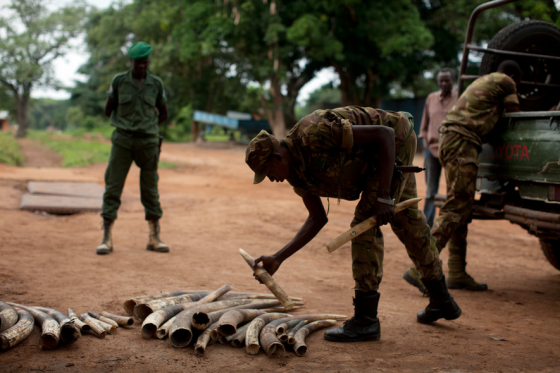In August, researchers released the Great Elephant Census, a report that reveals the extremely alarming impact poaching has on Africa’s savanna elephant population. The results of this census are a clear call to action to the entire international community. We must take significant steps through international policies and on-the-ground work to end the poaching and trafficking of African elephants, both for the sake of the creatures themselves and for the human populations they live alongside.

Final results of the elephant census
Source: The Great Elephant Census
To complete the study, members of the Elephant Census team flew over areas with savanna elephant populations and counted them from the air. The team also counted elephant carcasses in order to be able to estimate the rate of decline of savanna elephants. As a survey of over 350,000 elephants across 18 countries, the report shows that, between 2007 and 2014, savanna elephant populations have decreased by 30% (that’s a loss of 144,000 elephants) and the rate of decline today is even higher, at 8% per year.
What’s more, 84% of the elephants that were surveyed were found in legally protected areas, like national parks, but high numbers of elephant carcasses were found in both protected and unprotected areas. This shows that elephants are still being targeted by poachers in protected parks.
Armed groups like the LRA have used poaching as a survival tactic for years. Poaching gives armed groups access to ivory, which they are able to sell through black markets in order to fund further violence against local communities. We’ve also seen, through reports via our Early Warning Network and interviews with former LRA combatants, that while on poaching missions in areas in DRC’s Garamba National Park, LRA poachers often target local communities around the park with violent attacks.
Beyond the immediate danger poaching poses for local communities, it also creates a huge economic loss. While a poacher earns only a few hundred dollars for the ivory of a killed elephant, a live elephant could potentially bring surrounding communities involved in eco-tourism more than a million dollars. In just the first half of 2014, poaching is estimated to have cost local communities and economies over $44 million.

Source: The New York Times
With these facts in mind, it is imperative that we take action to prevent poaching. Fortunately, steps in this direction are already being made. Recently, the United States Senate passed the END Wildlife Trafficking Act, which will now continue on to the Oval Office to be decided upon by President Obama. This bill allows for a Presidential Task Force on Wildlife Trafficking to take action to stop the trafficking of many species around the globe, including African elephants, and has the potential to ignite global policies to combat wildlife trafficking.
The END Wildlife Trafficking Act also calls for the support, and even replication, of community conservation efforts. This is extremely important (and awesome!) because we know that community-based efforts are the best way to create lasting change.

Source: Brent Stirton
As we continue to advocate for policies like the END Wildlife Trafficking Act, we are also charging forward on front lines. Our Early Warning Radio Network is already giving central African communities around Garamba National Park where LRA and others often poach elephants and other wildlife, to take an active role in reporting nearby poaching activity to make their families safer and help conservation actors to prevent wildlife trafficking. If we hope to protect African elephants, encourage economic growth through eco-tourism, and protect communities from violence by poachers, we must take action immediately. Without effective, timely action, African elephants may disappear and local communities will not have the safety they deserve and need to thrive.
SUPPORT EFFORTS TO STOP WILDLIFE POACHING.
DONATE TO SUPPORT OUR EARLY WARNING NETWORK TODAY.
Think people should hear about this?